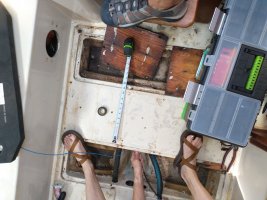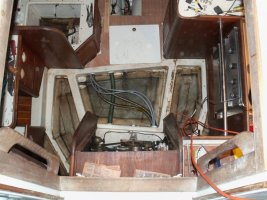Stuart 28-2
Member II
 1988 Ericsson 28-2. What do you all think of cutting an access hole 8" x 8" basically where the black electrical tape is, and, the likely integrity of the fibre glass repair work afterward?
1988 Ericsson 28-2. What do you all think of cutting an access hole 8" x 8" basically where the black electrical tape is, and, the likely integrity of the fibre glass repair work afterward?I posted about this on Aug 8th " Clog in bilge hose".
We are now into our 3rd consecutive weekend - both days and 7-8 evenings after work. Despite coming up with new plans, loss if blood, bruising, and strained muscles, we have gotten nowhere.
Neither the bilge hose or the hose for the shower sump will budge. We did manage to get out a section of the hose for the manual bilge that covers the jam point but it hasn't helped in getting the others free.
I believe the jam occurred when we made the mistake of trying to pull the hose out with brut force before knowing they take two close to 90 deg turns. Where you see the hole for the battery selector they are jammed under the low section below that.
We removed the water tank under the starboard settee which gave me access where I can get one hand on the hose through an access port there and the other hand on the hose through the hole for the battery selector ( that's how we got the manual hose out). Neither will budge pulling in either direction, one is starting to tear if we pull in direction toward bilge.
So, I am thinking the next plan is cut an access hole but I don't want to ruin the structural integrity of the floor system and worried patch and repair on the fiber glass won't be good enough.


